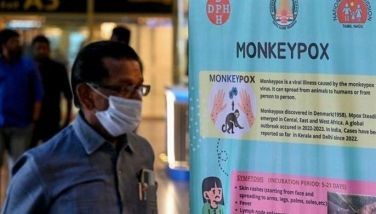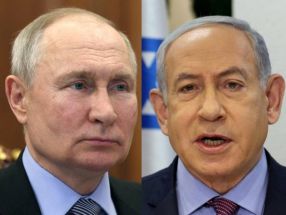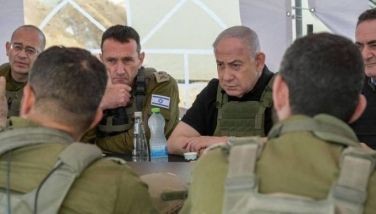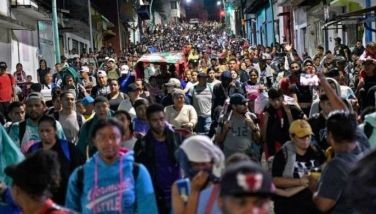Guatemalans use portraits, museum to seek missing
GUATEMALA CITY — As darkness fell over the peeling colonial houses of Guatemala City, eight young men and women crept through the streets carrying buckets of glue and photocopied pictures of people who'd been missing for decades.
They gathered at the foot of a house stained grey by car exhaust. One man smeared cheap white paste across the base of the nearest wall. A young woman stuck up dozens of handbills with the portraits of the disappeared — a wrinkled woman in a Mayan head wrap, a man wearing the broad lapels favored in 1980s Guatemala. Spray paint hissed as another woman wrote "No Amnesty, No Pardon" in big red letters alongside the portraits of the disappeared. In less than five minutes, the eight were gone, moving quickly to avoid the police.
Their loved ones were just a few of the 45,000 people who disappeared during Guatemala's 36-year civil war, virtually all at the hands of soldiers and allied paramilitaries seeking to wipe out a Marxist guerrilla movement. Almost all the victims are believed to have been killed, often after being raped, tortured, or both, then buried in mass graves, ditches and wells. Many were hurled from helicopters into the sea or volcanic craters. In total, at least 200,000 people were killed during the war.
Yet with fewer than 1,000 of the missing found, five successive right-wing Guatemalan governments have resisted local and international pressure to launch a full-scale effort to find and identify the rest.
Now, a handful of Guatemalans have launched homegrown attempts to draw attention to what human rights groups and the Inter-American Court of Human Rights call a deplorable lack of official action in the face of one of the worst unresolved cases of human-rights violations in the 20th century.
A month ago, about 20 relatives of the disappeared started nighttime forays through the streets of Guatemala City, pasting up tens of thousands of photos of the disappeared, most simple portraits copied from passports and other official documents.
Paulo Estrada was a year old when his father, a university student, disappeared in 1984. A military document leaked to human rights groups in 1999 said that he had been killed, but it didn't say where his body was left.
"I didn't even know him," Paulo Estrada said as he traveled the city pasting up photos of his father and other missing people on a recent Saturday afternoon. "But yes, I want to know where he is and what they did to him."
Families of the disappeared and slain have also built the Museum of the Martyrs and the Union, Student and Popular Movement of Guatemala, whose grand name belies its humble setting — a 30-by-18-foot garage and four small rooms in a converted single-family home.
In Guatemala's only monument to the disappeared, the remains of industrial union leader Amancio Villatoro lie on a red cloth in a glass case, surrounded by photos of him with his family. A member of the guerrilla wing of the Guatemalan Workers Party, he was kidnapped on Jan. 30, 1984, by men in plainclothes. His remains were found in a rural military outpost 27 years later.
Samuel Villatoro, the dead man's son and director of the museum, started weeping as he described how his father was held and tortured for 57 days, according to leaked military documents.
"We don't want to close this story by burying him," said Villatoro, who was eight when his father disappeared. "There's still no justice."
Some of the self-styled activists say they believe they can pressure the state to look for the missing. Others acknowledge that their efforts are unlikely to prompt action.
The activists say government action isn't the main goal, and that they mainly want to remember their loved ones, and force others to remember them, in a country that often seems determined to forget.
The Guatemalan government did not respond to several requests to comment on the topic.
The country's aggressive attorney general has prosecuted several high-ranking officials on war-crimes charges. But the highest-ranking, former dictator Jose Efrain Rios Montt, saw his conviction annulled this year in a high court decision that many saw as a sign of the lingering influence of the wartime military and its backers.
Estrada and his companions say they have posted 5,000 photos since they started about a month ago.
"We want to tell a story that's denied," said Eduardo Hernandez, whose family was one of the few to find the remains of their loved ones. His relatives found the bodies of his mother, grandmother and two uncles outside Guatemala City soon after they disappeared in 1984.
"This type of activity has been like therapy for us. People stop and ask us who these people in the photos are and we tell them our story. It's our way of easing the pain that lingers because of the absence of our loved ones."
In Nov. 2012, the Inter-American Court of Human Rights ruled against Guatemala in the disappearance of 26 people named in the leaked military files. The government has not complied with any of the terms of the court's ruling, including launching a search for the victims as quickly as possible, and building a park or plaza in the memory of the disappeared, where the families could gather to remember their loved ones.
The amateur museum, which opened last year, also contains tributes to Felix and Cesar Augusto Estrada Mejia, brothers, students and members of a guerrilla faction. Felix vanished in 1984, his killing registered in the leaked military document. Cesar Augusto disappeared in 1990 without a trace.
Their brother, Salomon Estrada, who works at the museum, said its purpose is "to remember them, to say that they existed and their relatives still want to know where they are."
A short distance away, the photo-posters gathered for a beer at the end of a night in which they plastered some 1,500 portraits on city walls.
As they planned their next outing, organizer Francisco Sanchez said they would have to keep moving quickly to avoid being hassled by police enforcing anti-graffiti and vandalism laws.
But even some police officers have been touched by the group's efforts, Sanchez said.
"We tell our story to some police and, believe it or not, they are moved and end up agreeing with us," he said.
- Latest
- Trending




























